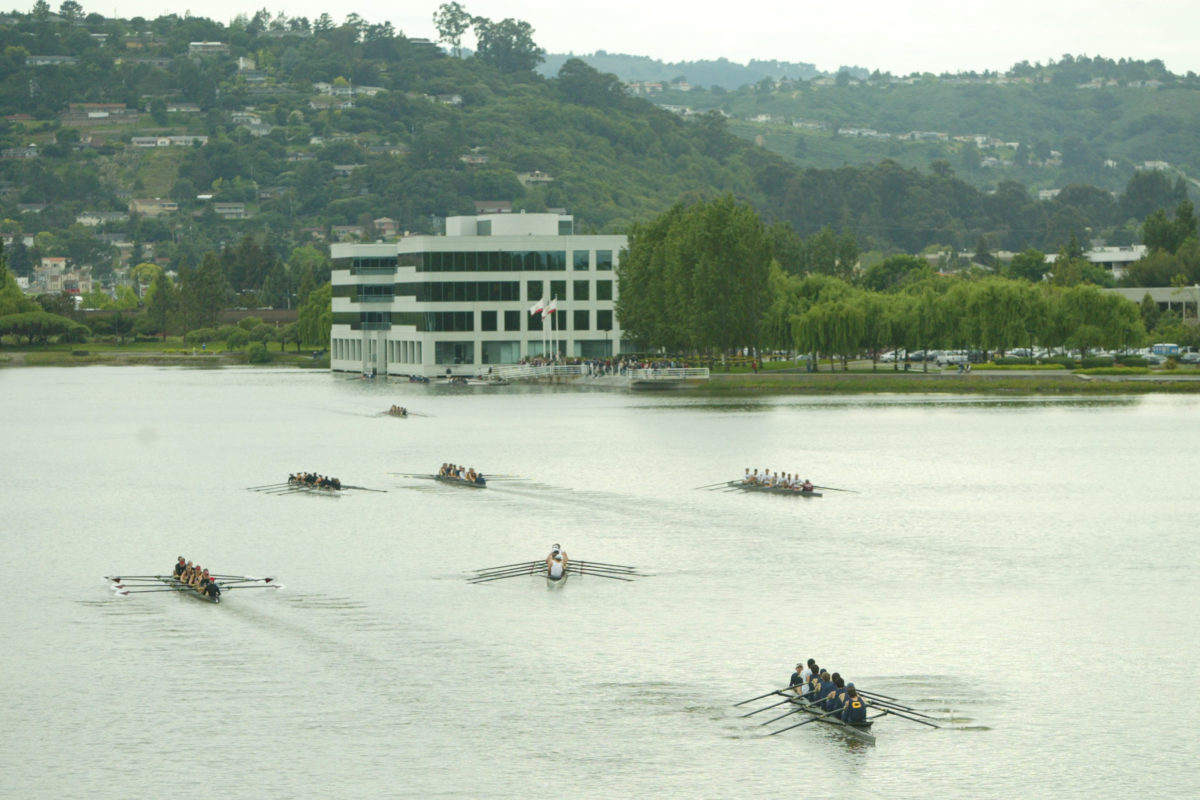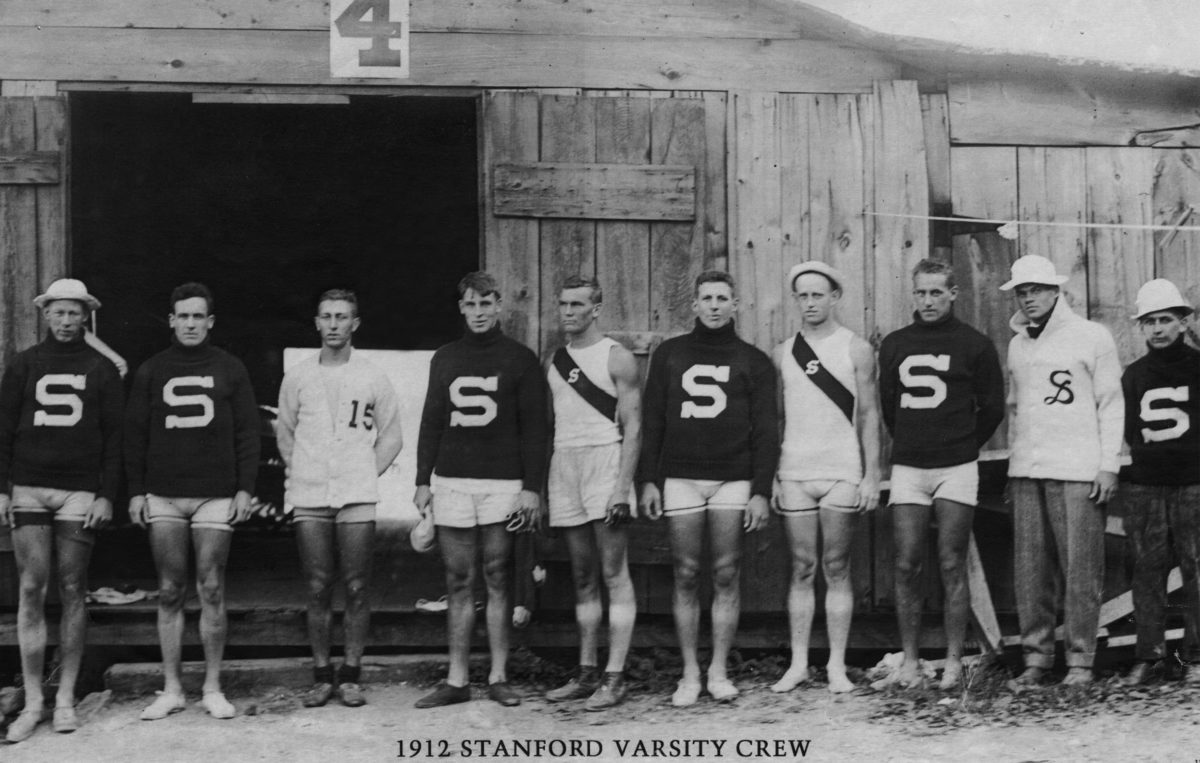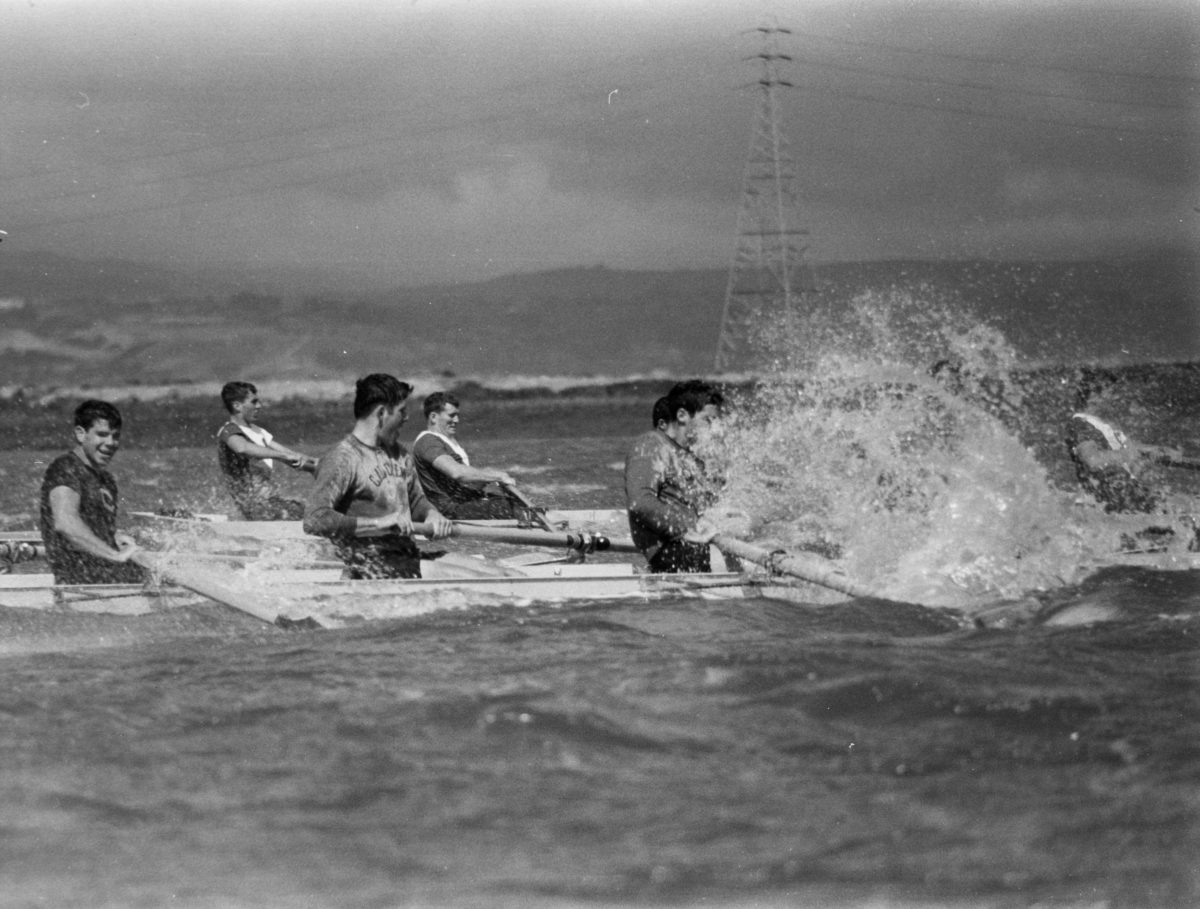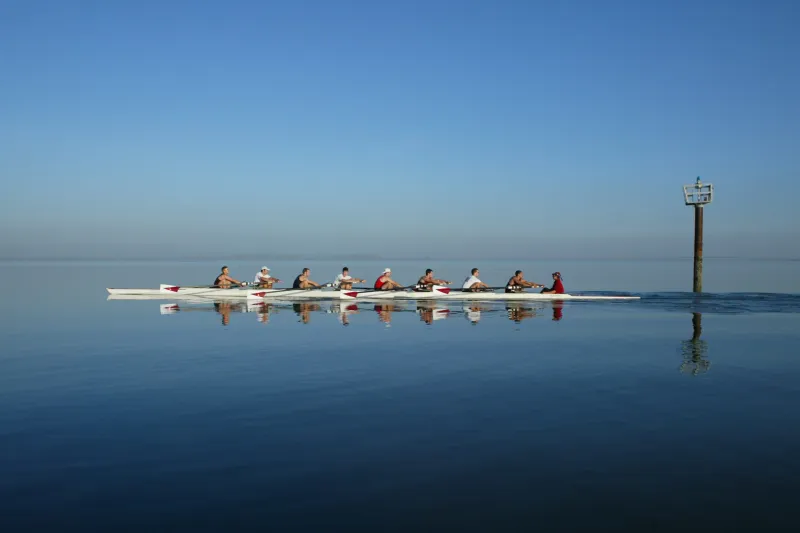“Upstream battle” is a series documenting the reactions of current men’s rowing athletes and alumni to the University’s announcement on July 8 that Stanford Athletics would discontinue 11 sports, including men’s rowing.
Only a few men’s rowers made it to the last-minute Zoom webinar with Athletic Director Bernard Muir last month. Some learned of the news through an old GroupMe chat shortly after, and others were in the dark until the University released an official announcement minutes later.
Trey Holterman ’21 was giving a presentation for his remote job at Strava, sharing his screen, when apology texts started pouring in.
Martin Amethier ’20 was winding down for the evening in Sweden when rowing group chats began to blow up.
“At first I almost thought it was a joke, but it seemed pretty serious,” Ametheir, one of the two 2020 co-captains, said. “It’s been a terrible year, and this was another punch in the gut.”
Despite the different means by which they found out, many alumni and current athletes shared the same shock at Stanford’s announcement.
The University offered that 36 varsity sports was not a “financially viable model,” citing past budget deficits along with financial burdens brought on by the pandemic. The University also noted that the rowing team does not have NCAA sponsorship” and less than nine percent of Division I institutions sponsor a varsity men’s rowing team.
The Intercollegiate Rowing Association (IRA) oversees men’s rowing, and the governing body, founded in 1895, began 11 year prior to the establishment of the NCAA.

Of the 39 total Division I schools that have rowing teams, nine, including Stanford, are based on the West Coast — including perennial powerhouses like Washington and cross-bay rival, California.
Regardless of the rationale behind the impending cancellation, many current athletes and alumni shared the sentiment that Stanford has recently lost sight of its values, citing a lack of communication during the decision-making process.
The University’s announcement stated that it had “explored all possible options” before making their final decision. Current student-athletes and alumni, however, were not contacted before the announcement on Zoom.
“It strikes me as a violation of some of Stanford’s core values in that, when you’re not sure about something, you reach out to external stakeholders for support and for engagement,” said Austin Hack ’14, a 2016 Olympian and a current member of the U.S. National Team. “To come out of nowhere and drop this with no forewarning or, to my knowledge, minimal effort to try and mitigate these problems within the community before the announcement is definitely upsetting to me and other alums.”
Holterman, who will co-captain the team next season with Nikita Lilichenko ’21, expressed disappointment with the lack of communication. He said that the University could not have exhausted all possible options without working with the team.
“I never saw Bernard in the launch. I never saw Marc Tessier-Lavigne out there,” Holterman said. “I’m sure they work with other student groups. I’m sure they understand how [those groups] impact the community…Why was there no interaction with us? [That’s] a massive failure.”
Jason Lupatkin ’13 described the decision as “uninspiring.”
“It’s backwards-looking and it’s just driven by a short-term dollars-and-cents view,” he said of the cut.
When asked for further comment, Stanford Athletics stated that an Associate Athletics Director held a one-hour meeting with the current team a few hours after the University’s announcement was made and made multiple attempts to schedule follow-up meetings with the head coach. A group of three alumni also met with Muir for about an hour last week, and Stanford Athletics plans to schedule a follow-up meeting.
None of the alumni interviewed, however, indicated that they were present for any meetings with administrative staff from the athletic department, nor were they aware of invitations to future meetings.
A Stanford Athletics spokesperson also did not offer further comment to directly address criticism from Lupatkin and other alumni.

The news is especially surprising given the recent success of the team. The Cardinal placed 10th in the IRA championships in 2019, and placed 3rd as a team at the Pac-12 Championships for three out of the last four years of competition. The men were unable to compete last spring because of COVID-19 cancellations.
The hiring of head coach Ted Sobolewski in 2019 seemed like an indication of growth and investment by Stanford in the sport. The University also built a new erg room and locker room for the team in Arrillaga Hall, which was completed in March 2020.
Bart Scherpbier ’19 was a member of the team as they transitioned head coaches, from Craig Amerkhanian to Sobolewski last spring. As he was finishing his senior year, Scherpbier remembered there being discussions about “coaching changes and which coach would be the best to uplift Stanford for years in the future.”
“It indicated…an expectation that Stanford rowing would last for a long time with varsity status and that it had the full support of the athletic department, ” Scherpbier said.
Despite the University offering club rowing as an alternative beyond 2021, many alumni and athletes were quick to point out that the IRA does not allow varsity teams to compete against club teams. Although there are nearly 150 club teams that are members of the American Collegiate Rowing Association, including teams like the University of Virginia that have sent former rowers to the Olympics, the rule preventing ACRA teams from competing against IRA teams will limit the amount of top-tier competition that Cardinal rowers will be able to row against. That will likely have a direct impact on the number of top recruits who choose Stanford, as well as each athlete’s ability to improve and develop in the sport.
Although the team has a strong walk-on tradition, with many former walk-on’s going on to succeed on the international stage, Holterman explained that “you can’t have an entire group of walk-ons and achieve the same level of competitiveness and drive.”
“Will all the facilities and resources still be there without the administrative support, and the ability to fly and host different competitions?” asked Adam Kreek ’07, a gold medal winner for Canada at the 2008 Olympics.“I don’t know what the future will look like in a club-based format. There’s a lot of uncertainty.”
The club sport alternative “is not the school offering a caveat — it’s them abandoning all responsibility, and I don’t even think it’s the least they can do,” Holterman added. “Creating a club is not offering any financial commitment.”
Rowers also fear that Stanford’s decision will encourage other schools to also cut their net-negative revenue sports like rowing, quickly decreasing the amount of opportunities for young athletes to compete at the next level.
George Washington University announced last week that it would cut seven sports — including men’s rowing, men’s and women’s squash and sailing — due to financial challenges posed by the pandemic. Schools like Brown University and the University of Connecticut have also discontinued sports since the pandemic started. And at many colleges, men’s rowing is among the first sports to get axed.
In the U.S., collegiate rowing programs are an important part of the development pipeline as athletes transition from high school competition to higher levels. With each university that cuts men’s rowing, the opportunity pool for young rowers to prepare for international competition shrinks.
Alumni said that Stanford’s cut will impact future performance of U.S. Rowing in the Olympics and World Championships, since the national body will likely no longer draw from Stanford rowers without varsity experience.
Since 1952, 20 former Cardinal have represented the United States or Canada in the Olympics. Most recently U.S. Rowing selected three current men’s rowers in April to participate in the 2020 under-23 national team camp.
By contrast, many other countries rely primarily on regional or state-based clubs to develop their young athletes, not college programs.

In response to Stanford’s decision, a group of over 1000 current athletes, alumni, parents and supporters of the rowing community created Save Stanford Rowing, an initiative with the goal of bringing the men’s and lightweight women’s rowing teams back to a varsity status. The website includes a petition, which has garnered more than 4,000 signatures at the time of publication, and an open call for supporters to offer various forms of assistance. Current and former athletes also shared testimonials explaining what the team means to them and the importance of reinstating the sport on the varsity level.
“What better legacy than to support a sports program at a world renowned university that will train the minds of young [athletes] for generations to come?” Kreek asked.
Contact Sofia Scekic at sscekic ‘at’ stanford.edu and Karlaine Francisco at itskarlaine ‘at’ gmail.com.
